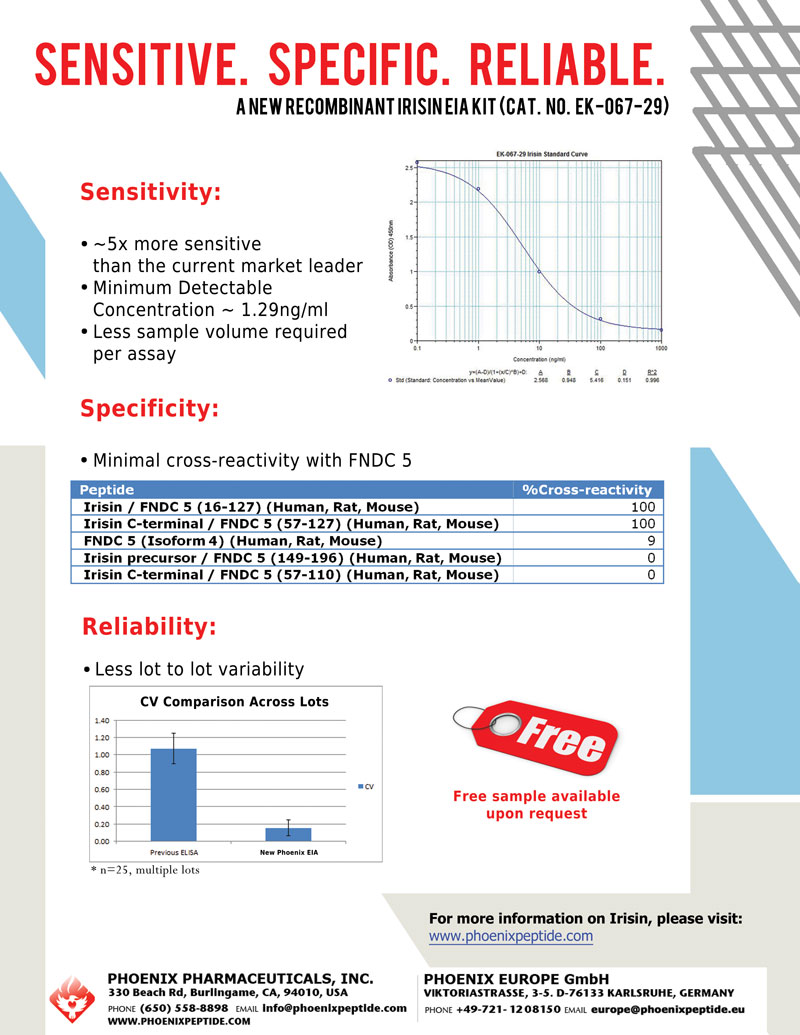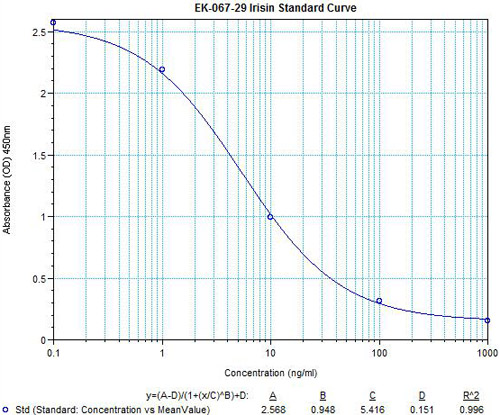|
|
|
Novel Applications for Irisin
|
The Identification of Irisin in Human Cerebrospinal Fluid |

See more information at Irisin
Background: Peripheral action of irisin improves glucose homeostasis and increases energy expenditure, with no data on a central role of irisin in metabolism. These studies sought to examine (1) presence of irisin in human cerebrospinal fluid (CSF) and banked human hypothalamic tissue, (2) serum irisin in maternal subjects across varying adiposities with or without gestational diabetes (GDM), and (3) their respective neonate offspring.
Methods: CSF, serum and neonatal cord serum were collected from 91 pregnant women with and without GDM attending for an elective Caesarean section (BMI: 37.7±7.6 Kg/m2; age: 32±8.3 years). Irisin was assessed by ELISA and correlated with biochemical and anthropometric dxata. Irisin expression was examined in human hypothalamus by immunohistochemical staining.
Results: Serum irisin in pregnant women was significantly lower in non-obese compared to obese and GDM subjects, after adjusting for BMI, lipids and glucose. Irisin was present in neonatal cord serum (237±8ng/ml) and maternal CSF (32±1.5ng/ml). CSF irisin correlated positively with serum irisin levels from non-obese and obese pregnant women (p<0.01), with CSF irisin significantly raised in GDM subjects (p<0.05). Irisin was present in human hypothalamic sections in the paraventricular neurons, co-localized with neuropeptideY.
Conclusions: Irisin was detectable in CSF and in paraventricular neurons. Maternal serum irisin was lower in non-obese pregnant women after adjusting for BMI and a number of metabolic parameters. These studies indicate that irisin may have a central role in metabolism in addition to the known peripheral role. Further studies investigating the central action of irisin in human metabolic disease are required.
Piya MK, Harte AL, Sivakumar K et al., Am J Physiol Endocrinol Metab. 2014 Jan 7. [Epub ahead of print]
Irisin was identified as a myokine secreted by contracting skeletal muscle, possibly mediating some of exercise health benefits via "browning" of white adipose tissue. However, a controversy exists concerning irisin origin, regulation&function in humans. Thus, we have explored Fndc5/irisin in 2 clinical studies: (i) a cross-sectional study (effects of type-2-diabetes (T2D) in drug-naïve men); (ii) an intervention study (exercise effects in sedentary, overweight/obese individuals). Methods. Glucose tolerance and insulin sensitivity were assessed. VO2max and muscle strength were measured before and after training. Body composition (MRI), muscle&liver fat content (1H-MRS) and in vivo muscle metabolism (32P-MRS) were determined. Skeletal muscle and subcutaneous abdominal adipose tissue samples were taken in the fasted state, during euglycemic hyperinsulinemia (adipose tissue) and before/after exercise training (muscle). Results. Muscle Fndc5 mRNA was increased in prediabetes but not T2D. Fndc5/irisin in adipose tissue/plasma were reduced in T2D by 40% and 50%, respectively. Opposite to that, T2D-derived myotubes expressed/secreted the highest levels of Fndc5/irisin. Neither hyperinsulinemia (adipose tissue/plasma) nor exercise (muscle/plasma) affected Fndc5/irisin in vivo. Circulating irisin was positively associated with muscle mass, strength and metabolism and negatively with fasting glycemia. Glucose and palmitate decreased Fndc5 mRNA in myotubes in vitro. Conclusions. Distinct patterns of Fndc5/irisin in muscle, adipose tissue nad circulation and concordant in vivo down-regulation in T2D indicate that irisin might distinguish metabolic health and disease. Moreover, Fndc5/irisin was discordantly regulated in diabetic muscle and myotubes in vitro, suggesting that whole-body factors, such as glucose and fatty acids, might be important for irisin regulation. Exercise did not affect Fndc5/irisin. However, irisin was positively linked to muscle mass, strength and metabolism, pointing to common regulatory factors and/or the potential for irisin to modify muscle phenotype.
  |  |
Fig.1 of example #1 . Plasma irisin concentration (A) and Fndc5 gene expression in skeletal muscle (C) and subcutaneous adipose tissue (E) in individuals with obesity, prediabetes and type 2 diabetes. Data are shown as means ±SEM.
*p<0.05. ** p<0.01. *** p<0.005 |
| 
| Subset of the 21 plasma samples from the study were measured with a more recently developed recombinant irisin EIA kit (#EK-067-29). This assay provided authors with identical results, but revealed that previously measured plasma concentrations might be underestimated by approximately 25 fold. |

Figure 3 of example #1. Fndc5/irisin Subset of the differentiated human primary muscles originating from lean, obese, prediabetes and tupe 2 diabetic individuals. (A) Fndc5 mRNA in differentiated human primary muscle cells number of samples from experiment 2. (B) Irisin in the conditioned media from human primary muscle cells. Data are shown as means ± SEM.
* p<0.05.
Kurdiova T, Balaz M, Vician M et al., J Physiol. 2013 Dec 2. [Epub ahead of print]
Irisin was first identified as a peroxisome proliferator-activated receptor γ co-activator-1α (PGC-1α) dependent myokine with the potential to induce murine brown-fat-like development of white adipose tissue. In humans, the regulatory effect of training on muscle FNDC5mRNA expression and subsequently irisin levels in plasma is more controversial. We recruited 26 inactive men (13 normoglycaemic and normal weight, controls; and 13 slightly hyperglycaemic and overweight, pre-diabetes group) aged 40-65 years for a 12-week intervention of combined endurance and strength training with four sessions of training per week. Before and after the 12-week intervention period, participants were exposed to an acute endurance workload of 45 min at 70% of VO2max , and muscle biopsies were taken prior to and after exercise. Skeletal muscle mRNA for PGC1A and FNDC5 correlated and both PGC1A and FNDC5mRNA levels increased after 12 weeks of training in both control and pre-diabetes subjects. Circulating irisin was reduced in response to 12 weeks of training, and was increased acutely (~1.2-fold) just after acute exercise. Plasma concentration of irisin was higher in pre-diabetes subjects compared with controls. There was little effect of 12 weeks of training on selected browning genes in subcutaneous adipose tissue. UCP1mRNA did not correlate with FNDC5 expression in subcutaneous adipose tissue or skeletal muscle or with irisin levels in plasma. We observed no enhancing effect of long-term training on circulating irisin levels, and little or no effect of training on browning of subcutaneous white adipose tissue in humans.

Figure S1 of example #2. Changes in plasma levels of irisin in healthy controls (n=9) and prediabetes subjects (n=8) in response to 12 w of training. Student’s t-test was used for single comparisons. Plasma irisin levels were determined using Phoenix Pharmaceutical's Irisin EIA Kit (#EK-067-29).
Norheim F, Langleite TM, Hjorth M, et al., FEBS J. 2013 Nov 15. doi: 10.1111/febs.12619. [Epub ahead of print]
OBJECTIVE: Irisin has recently been introduced as a novel an exercise-inducible myokine which improves glucose metabolism in mice. However, regulation of circulating irisin in gestational diabetes mellitus (GDM) and in the peripartal period has not been assessed so far.
METHODS: Circulating irisin was quantified in 74 GDM patients and in 74 healthy, pregnant, gestational age-matched controls. In a subset of these patients (44 GDM, 41 controls), postpartum follow-up data were also available. In a second study population of 40 healthy women with singleton pregnancies undergoing elective Cesarean section, irisin was assessed in maternal serum before and within 24h after delivery, as well as in umbilical cord blood and in placental tissue.
RESULTS: In the first study population, median [interquartile range] irisin levels were significantly higher in GDM patients as compared to controls after delivery (previous GDM: 446.3 [146.9]μg/l; controls: 378.0 [111.4]μg/l) but not during pregnancy (GDM: 482.1 [132.1]μg/l; controls: 466.6 [178.0]μg/l). Interestingly, fasting insulin (FI) was independently and positively associated with serum irisin in multivariate analysis during pregnancy. In agreement with these findings, relative changes (ratio) of FI independently and positively predicted relative changes of irisin (ratio) in the second study population.
CONCLUSIONS:
The myokine irisin is independently associated with FI in pregnancy. The physiological significance of these findings needs to be assessed in future experiments

Irisin levels were determined using Phoenix Pharmaceutical's Irisin EIA Kit (#EK-067-29).
Ebert T, Stepan H, Schrey S, et al., Cytokine. 2013 Dec 16. pii: S1043-4666(13)00759-X. doi: 10.1016/j.cyto.2013.11.009. [Epub ahead of print]
Context: Irisin, a recently identified hormone, has been proposed to regulate energy homeostasis and obesity in mice. Whether irisin levels are associated with risk of the metabolic syndrome (MetS), cardiometabolic variables, and cardiovascular disease (CVD) risk in humans remains unknown.
Objective: Our objective was to assess the associations between baseline serum irisin levels and MetS, cardiometabolic variables, and CVD risk. Design, Setting, and Subjects: We conducted a comparative cross-sectional evaluation of baseline circulating levels of the novel hormone irisin and the established adipokine adiponectin with MetS, cardiometabolic variables, and CVD risk in a sample of 151 subjects.
Results: Baseline irisin levels were significantly higher in subjects with MetS than in subjects without MetS. Irisin was associated negatively with adiponectin (r = -0.4, P < .001) and positively with body mass index (r = 0.22, P = .008), systolic (r = 0.17, P = .04) and diastolic (r = 0.27, P = .001) blood pressure, fasting glucose (r = 0.25, P = .002), triglycerides (r = 0.25, P = .003), and homeostasis model assessment for insulin resistance (r = 0.33, P < .001). After adjustment for potential confounders, including body mass index, subjects in the highest tertile of irisin levels were more likely to have MetS (odds ratio [OR] = 9.44, 95% confidence interval [CI] = 2.66-33.44), elevated fasting blood glucose (OR = 5.80, 95% CI = 1.72-19.60), high triglycerides (OR = 3.89, 95% CI = 1.16-13.03), and low high-density lipoprotein cholesterol (OR = 3.30, 95% CI = 1.18-9.20). Irisin was independently associated with homeostasis model assessment for insulin resistance and general Framingham risk profile in multiple linear regression analyses after adjustment for confounders. Adiponectin demonstrated the expected associations with outcomes.
Conclusions: Irisin is associated with increased risk of MetS, cardiometabolic variables, and CVD in humans, indicating either increased secretion by adipose/muscle tissue and/or a compensatory.

Irisin levels were determined using Phoenix Pharmaceutical's Irisin EIA Kit (#EK-067-29).
Hee Park K, Zaichenko L, Brinkoetter M, et al., J Clin Endocrinol Metab. 2013 Dec;98(12):4899-907. doi: 10.1210/jc.2013-2373. Epub 2013 Sep 20.
OBJECTIVE: A recently discovered myokine, irisin, may have an important role in energy metabolism. This study aimed to evaluate the relationship between this hormone and the lipid profile of Metabolic Syndrome (MetS) patients following a hypocaloric diet.
DESIGN: Ninety-three Caucasian adults (52 men/41 women) diagnosed with MetS followed an 8-week-long energy restricted programme (-30% of the energy requirements). Anthropometric measurements, biochemical markers and plasma irisin levels were analysed before and after the nutritional intervention.
RESULTS: Global plasma irisin levels were significantly reduced at the end of the study (-72·0 ± 100·9 ng/mL, p < 0·001) accompanying the weight loss (-6·9%). The depletion of irisin significantly correlated with changes in some atherogenic-related variables: total cholesterol (B = 0·106, p = 0·018), total cholesterol/high density lipoprotein-cholesterol ratio (B = 0·002, p = 0·036), low density lipoprotein-cholesterol (B = 0·085, p = 0·037) and apolipoprotein B (B = 0·052, p = 0·002), independently of changes in body weight.
CONCLUSIONS:An association between the reduction of plasma irisin levels and the depletion of important lipid metabolism biomarkers was observed in patients with MetS undergoing an energy restricted programme.


|
|
|
Irisin;Irisin antibody publication china
EK-067-29
|
|
|


